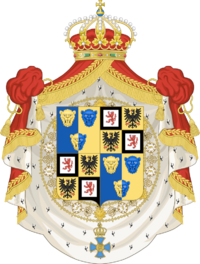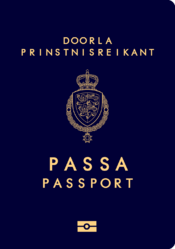Coat of arms of Durland
| Coat of arms of Durland | |
|---|---|
 Greater (royal) version | |
| Versions | |
 Lesser (state) version | |
| Armiger | Carilla, Queen of Durland |
| Adopted | 9 April 1928 |
| Torse | tasseled strings Or |
| Blazon | Per pale Azure and Or two lions rampant all counterchanged within a bordure argent. |
| Orders | Order of Prince Jora |
| Other elements | The monarch places this coat of arms on a mantle gules lined with Ermine. Above the mantle is a pavilion gules again topped with the royal crown. |
The coat of arms of Durland is the arms of dominion of queen Carilla of Durland, and is used to represent both the monarch and the kingdom. It depicts two lions countercharged onto a vertically-divided shield of blue and gold, within a white border (Per pale Azure and Or two lions rampant all counterchanged within a bordure argent.)
The coat of arms is used by the Queen, Parliament, and the Supreme Court. Members of the Royal Family use the arms charged with a label of difference and a crown of rank. The government uses a variation of the arms, without the mantle and with the shield crowned, which is known as the state arms.
History
The first coat of arms used by the Kingdom of Durland, from its establishment in 1878 until the abolition of the monarchy in 1922, was designed by King Garmanas II. Garmanas, an amateur herald and artist, designed the coat of arms originally on the back of an envelope whilst travelling from Nelin to Alduar en route to Herran. The arms were inspired by those of Prince Jora, Grand Prince of the Durlish Principalities, who reigned from 1527 until 1561. The arms, consisting of golden lions on a blue shield, were then countercharged to represent what the King called "the two Durlands," those being the early modern state of the sixteenth and seventeenth centuries and the modern state of the nineteenth century. The inclusion of a white border (bordure argent) was another creation of the King. In early modern Durlish heraldry, a bordure represented an adopted son. The King outlined the meaning of the border in the Durlish coat of arms in a letter to Usror Sode:
My family come from afar. I am, in many ways, a stranger to this country. I know its customs and its people, its cities and towns and landscapes, yet I feel that I will always be an outsider. Nonetheless, I remain so very thankful that Durland adopted me. In these arms, which I now possess, I wanted to show my awareness of my alienness - that my blood may not be like yours - but also my dedication to this great country and to its people.
The coat of arms were formally registered with the Court of Arms of the Kingdom in 1879, but were de facto used from their creation a year prior.
Description
The current coat of arms was adopted in 1928 following the re-establishment of the monarchy. It is closely modelled on the coat of arms previously used from 1878 until 1922. As per the registration with the Court of Arms of the Kingdom, the escutcheon is blazoned: Per pale Azure and Or two lions rampant all counterchanged within a bordure argent. The shield is surrounded by the insignia of the Order of Prince Jura, and all surrounded by mantling Gules doubled ermine, crowned with the royal crown and tied up with tassled strings Or.
The rules outlining the design and use of the coat of arms, including variations and eligibility, continue to be based on those made by Garmanas II.
Usage
The proper use of the Durlish coat of arms is regulated by law. The National Sybols Act 2003, which updated and consolidated existing legislation relating to the coat of arms, identifies three types of arms used in Durland: the great coat of arms, the state coat of arms, and the shield of arms (or escutcheon).
- The great coat of arms is the arms of dominion of the Durlish monarch, and subsequently serves as the coat of arms of the King and Queen and also of the state. It is used to represent the Crown and the nation.
- The state coat of arms is the arms used by the government and government entities. It is used to denote a relationship with the state and, in a broader sense, ownership and oversight by the government.
- The shield of arms is the general design of the escutcheon, as used in either the great or state coat of arms or as part of the personal arms of individuals.
The distinction between the great coat of arms and the state coat of arms is not clearly made. In general, outside of the monarchy the great coat of arms is a symbol of the nation itself, whereas the state coat of arms is a symbol of its government. The Durlish passport, for example, uses the great coat of arms, whilst the logos of government ministries uses the state coat of arms.
Variants
Royal versions
Gallery
- Coats of arms of the Monarch
- Coats of arms of members of the Royal House
- Coat of arms of members of the Royal Family and other variants












